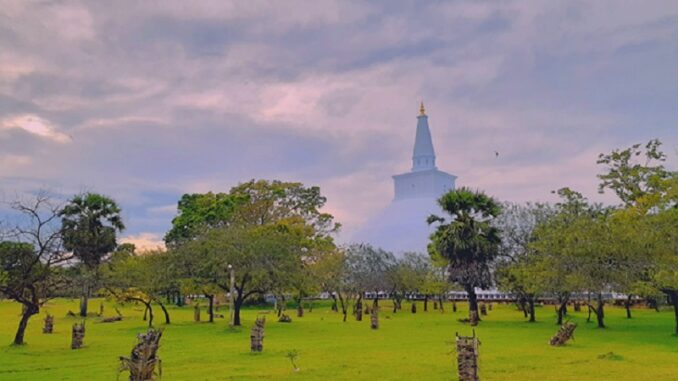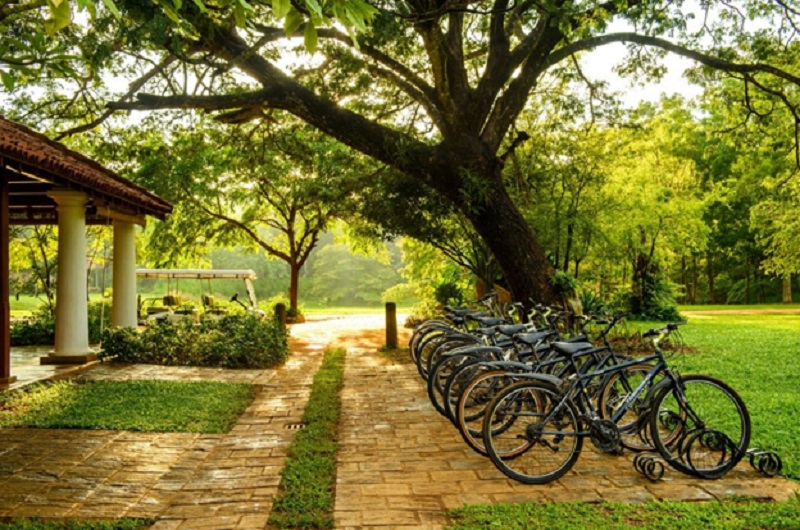
A seat of ancient kings, a one time capital and city of administration, an archaeological treasure trove, a place renowned for learning, a pilgrim’s joy, all of these can well describe this city that’s named Anuradhapura or City of Anuradha (who is said to be a minister in King Vijaya’s court).
Situated 205 km north of Colombo, Anuradhapura is currently the capital of the North Central Province (NCP) of Sri Lanka and can be reached by road, rail or air from Colombo, Galle, Jaffna, Trincomalee, etc. It is a World Heritage Site and has been so since 1982.
Anuradhapura – Ancient City
Steeped in history, Anuradhapura is said to have been made a prosperous city and the capital of Sri Lanka for the first time by king Pandukabhaya, the first Sinahlese king.
The Anuradhapura Period of history of Sri Lanka dates from 437 BC to 1017 AD and notable among the several kings that ruled from Anuradhapura after Pandukabhaya are Dutugemunu who unified the country and ruled from this city and Valagamba, Mahasen and Dathusena. The first queen to rule Sri Lanka, Queen Anula also reigned from this city.
It was during the rule of King Devanampiyatissa from this city but before the reign of Pandukabhaya, that India’s Emperor Asoka’s son Mahinda Thero arrived and first preached Buddhism. After the conversion of King Devanampiyatissa the people of Sri Lanka embraced Buddhism and later Mahinda Thero’s sister Sangamiththa Therani brought a sapling of the Bo Tree (ficus religiosa) under which Buddha attained Enlightenment and planted in this multifaceted city. Thus, the Jaya Sri Mahabodhi, sacred to Buddhists all over the world, is considered the first among the eight important religious sites (Atamastana) found in this city inspired by Buddhism.
Ruins of Anuradhapura
Having been the established capital of ancient Ceylon from which ruled many kings during the 1400 year “Anuradhapura Period”, one does not have to wonder why there are so many palaces spread through the city, though unfortunately in ruins.
After Buddhism became the religion of the kings and people, the kings who ruled from Anuradhapura built several grand relic chambers known as dagobas or stupas or chaityas and the city is dotted with these. Travellers to this ancient city should consider as a must, visits to these stupas to venerate the relics of Buddha or simply to marvel at the ancient grandeur of the city. Notable among these would be the eight sites of veneration known as “Atamasthana” i.e. Jaya Sri Mahabodhiya (the Sacred Bo Tree), Ruwanweliseya, Abayagiri Viharaya, Jetavanaramaya, Mirisawetiya, Lovamahapya, Thuparamaya and Lakaramaya. As in the case of the reservoirs and castles, visitors to these temples and dagobas must surely wonder at the marvelous edifices created in such ancient times sans the knowledge and tools available to today’s engineer.
“Isurumuniya” is another site not to be missed by travellers, particularly lovers of history, arts and ancient cultures of the orient. It is where stone carvings of a couple known as the lovers of Isurumuniya can be found and gives testimony to the skills of the ancient stone carver.
Though Buddhist religious sites dominate this once thriving Kingdom one finds that Christianity has had a niche in Anuradhapura. Excavations in 1912 revealed a Cross now known as the Anuradhapura Cross, said to be from 500 AD belonging to Persian Christians. In addition, there are Hindu Kovils also found in this city, once the capital of Sri Lanka from which ruled Chola and Tamil Hindu kings whenever they deposed Sinhala kings.
Once a thriving kingdom, Anuradhapura, though no longer the capital of the country, is a place for the discerning tourist, historian, archaeologist or even the student of hydro engineering.
Weather in Anuradhapura
Anuradhapura is situated in the Dry Zone and so visitors can enjoy the sightseeing almost throughout the year. This dry weather was the very reason some of the ancient kings of Anuradhapura who were keenly interested in irrigation and agriculture constructed several large reservoirs (called tanks) and canals which bear testimony to the knowledge and skills of these kings and their courtiers. The Nuwara wewa (wewa is the Sinhala word for tank or reservoir), the largest of the reservoirs, is said to have been built in the 1st century AD. The other two notable reservoirs are the Basawakkulama and Tisa Wewa. As visitors stroll along the bund of a reservoir or visit ruins of a castle they cannot but wonder how such marvels were created without the modern day engineering tools.
Things to do in Anuradhapura
Anuradhapura has so much to offer the discerning tourist. Archeological sites are aplenty in Anuradhapura and you will not feel the time pass while visiting these. On the other hand you might take a quiet walk along the buds of the several reservoirs in the cool of the morning or while the sun sets in the evening.
Hotels in Anuradhapura
A visitor to Sri Lanka should make this historic city a must visit place, which also offers accommodation with star class luxury to the traveller. Most hotels will offer to arrange trips to different sights to be seen in and around Anuradhapura or you may simply use public transport which may be crowded but available at convenient times to visit the many interesting spots.

Travel to Sigiriya, Polonnaruwa or Wilpattu from Anuradhapura
Traveling to other places of interest from Anuradhapura by road is convenient. Sigiriya and Polonnaruwa are two towns of historical interest and Wilpattu a haven for wildlife. Sigiriya is less than 80 Km from Anuradhapura and can be reached in under 90 minutes. Polonnaruwa, another ancient kingdom of Sri Lanka is 103 Km away and about 2 hours by road. Wilpattu is only 41 Km from Anuradhapura and can be reached one and a quarter hours.